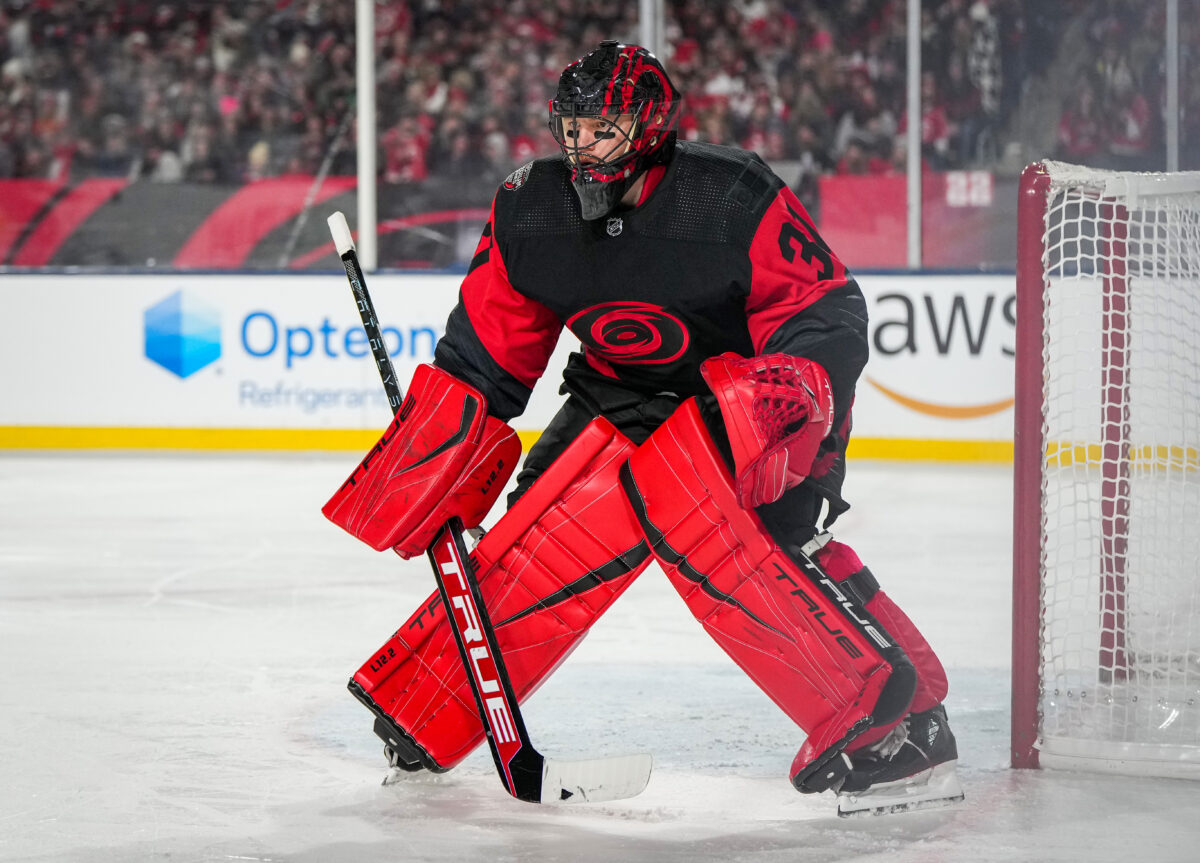“We really don’t have an update on that. That’s a long, long-term thing,” Carolina Hurricanes head coach Rod Brind’Amour said about goalie Frederik Andersen‘s recovery timeline while speaking to a press scrum in Edmonton on Tuesday (Dec. 5).
Everyone was shocked in early November when the Hurricanes announced that Andersen was “dealing with a medical issue and undergoing evaluations,” via the team’s Public Relations X – formerly known as Twitter – account.
Goaltender Jaroslav Halak is joining the Hurricanes as a free agent tryout. Frederik Andersen is dealing with a medical issue and undergoing evaluations. An update will be provided when available, but no further comment will be issued until that time.
— Hurricanes PR (@CanesPR) November 6, 2023
It’s also important in stories like this to remember the human being affected and the privacy they deserve. Yes, even professional athletes deserve privacy when dealing with unforeseen medical issues. While reading this story you’ll notice I don’t assume what Andersen’s exact diagnosis was. Nor will I try to predict a timeline for his return.
Don Waddell’s Announcement
“During recent medical testing, it was discovered that Frederik Andersen had a blood clotting issue that needed to be addressed. There is currently no timetable for his return, but we are confident that Freddie will be able to make a full recovery,” said Hurricanes general manager Don Waddell in a statement on Nov. 6.
Fans of a certain age might wince at the mention of blood clots. Hearing those words from a doctor could mean new medication and a lifestyle change. Less salty foods, more baggy clothes, and sleeping at an angle to encourage blood flow throughout the night. It can often be scary news to receive. Blood clots, however, are often given a bad rap. The majority of the time they serve a vital role in the body’s healing process.
Say you’re walking down the sidewalk and tripped on uneven pavement scratching your knee. Blood clots would form to stop the bleeding. Fragments of white blood cells, known as platelets, working their way through the affected blood vessel begin to attach themselves to the abrasion. Over time the cells began to form a natural barrier to stop bleeding internally. Simply put, blood clots stop more blood cells from escaping the bloodstream.
Clots become problematic when they form without need. When blood flow is impeded, they can form within the vessel and travel around the body to your limbs, lungs, kidneys, heart, and brain causing organ damage and even death.
Blood Clots in Hockey
Long-term fans of the game know Andersen isn’t the first NHLer to be diagnosed with a blood clot condition. Fans of hockey history might know the story of Howie Morenz – a member of the inaugural Hockey Hall of Fame class in 1945, a three-time Stanley Cup champion, a Montreal Canadiens legend, and a member of the NHL’s 100 Greatest Players list.
Related: Howie Morenz: Hockey Royalty
Morenz is known as one of the greatest players of his generation. He’s also the first NHLer known to have died as a result of a pulmonary embolism in 1937. Six weeks after fracturing his leg in a game against the Chicago Blackhawks, 10,000 mourners packed the Montreal Forum to say their final goodbyes.
Not every story has such a tragic ending. Tampa Bay Lightning goalie Andrei Vasilevskiy was sidelined at the start of the 2015-16 season after requiring surgery to remove a blood clot. In the years since he won the Vezina Trophy in 2019, the Conn Smythe in 2021, and back-to-back Stanley Cup championships in 2021 & 2022, he is widely considered the best goaltender of his generation.

Vasilevskiy and Morenz are only two of the more than a dozen NHLers with records of blood clots. Former Pittsburgh Penguins goalie and 16-year NHL veteran Tomas Vokoun missed the 2013-14 season due to blood clots before announcing his retirement in the offseason.
In 2006, New York Rangers winger Jed Ortmeyer was diagnosed with a pulmonary embolism believed to be treatable with medication. He eventually returned to play, managing daily anticoagulant injections and monthly ultrasound examinations. While his career continued, the constant worry never faded. He retired from the game in 2014.
Are Players at Risk?
“For NHL Players and Other Athletes, Blood Clots Are a Deadly Threat” was published in December 2014 by Sports Illustrated. The title might be crafted to get clicks, but the information it shares is eye-opening.
In contact sports like hockey, hard hits can cause trauma, large and small, internally. And then sitting on long, cross-country flights—particularly after games when dehydration causes the blood to thicken—inhibits circulation, often causing blood to pool in the legs, where platelets may gather and form a clot. It’s not common, but given the constant travel of professional athletes, their chances of developing a clot are heightened.
Often, though, blood clots in athletes stem from surgery and the subsequent immobilization.
“[Undergoing] any of these surgeries—like joint surgeries, where you’re going to be laid up for a period of time and you’re not able to use your legs like you normally would—does predispose you to getting these clots,” says Dr. Peter Vitanzo, a sports medicine specialist with the Rothman Institute in Philadelphia.
For NHL Players and Other Athletes, Blood Clots Are a Deadly Threat
Sports Illustrated – Dec 16, 2014
Canadian Press published “More Hockey Players Being Diagnosed with Blood Clots Than Ever” just a few months later in February 2015. Sports Illustrated approached the subject based on what factors in a professional athlete’s life can contribute to developing blood clots. On the other hand, the Canadian Press approached it from the data side asking if the number of players with blood clot conditions is consistent with the average, or if a larger percentage of players develop clots compared to non-players.
There’s no substantial evidence to suggest athletes, especially in a contact sport like hockey, are more likely to suffer blood clots than other people, according to Dr. William Geerts of Sunnybrook Health Sciences Centre in Toronto. With one out of every 1,000 people getting a clot each year, it’s not more prevalent in hockey players, but Geerts said trauma from injuries could play a factor.
“It’s possible that really intense athletic activity could induce some clotting,” he said. “In many people there are risk factors that would apply to all of us.
“So if I break my ankle, then I could get a blood clot, too, just like an athlete could.”
More Hockey Players Being Diagnosed with Blood Clots Than Ever
The Canadian Press – Feb 27, 2015
After reading the two articles, it’s clear that professional athletes commonly participate in activities known to increase their chances of developing a blood clot. We all have different risk factors based on our environment, hereditary traits, diet, and more. A professional athlete, at least according to Dr. Geerts, is at no greater risk than a non-athlete performing the same activities.
Back to Frederik Andersen
Why did I decide to share all this with you? At this moment, we know almost nothing about Andersen’s illness. All we’ve been told is he “had a blood clotting issue that needed to be addressed.” And they’re “confident that Freddie will be able to make a full recovery.”

Rod Brind’Amour’s update on Tuesday, “We really don’t have an update on that. That’s a long, long-term thing,” didn’t tell us anything we didn’t already assume. I’ve seen tons of Hurricanes fans grasping at straws trying to figure out when Andersen might return. In the interest of teaching rather than lecturing, I thought I would show you that blood clots are uncharted territory. At this point, all anyone can do – including Andersen – is wait and see how his treatment works out. No timetable or expectations, just patience and support.
